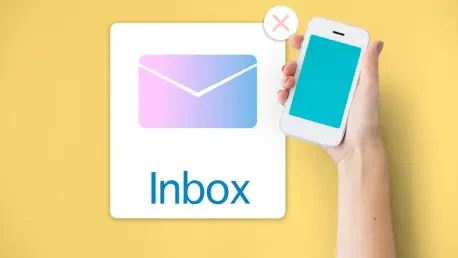In today’s hyper-connected digital world, consumers face an avalanche of marketing messages every single day, with estimates suggesting that the average person encounters thousands of ads across various platforms before they even finish their morning coffee. Standing out in this crowded space has become a monumental challenge for businesses striving to capture attention and drive action. Personalized marketing automation emerges as a powerful solution, leveraging technology to deliver tailored experiences at scale while aiming to maintain a sense of genuine connection with customers.
The Power of Personalization in Marketing Automation
Why Personalization Boosts Engagement and ROI
Personalized marketing campaigns consistently outperform generic ones, with industry studies showing significant uplifts in key performance indicators. Reports indicate that emails with personalized subject lines achieve open rates up to 26% higher than standard ones, while click-through rates can increase by as much as 14%. Conversion rates also see a notable boost, often doubling when content aligns closely with individual preferences, demonstrating the tangible impact on bottom-line results.
Beyond immediate metrics, personalization fosters deeper customer loyalty, as tailored experiences make individuals feel valued rather than just another data point. This approach also optimizes marketing budgets by focusing resources on highly receptive segments, reducing waste on broad, ineffective outreach. As a result, businesses adopting this trend are seeing not only short-term gains but also sustained growth in customer relationships.
The growing adoption of personalized strategies underscores their importance in a competitive market. Companies that prioritize relevance over volume are better positioned to turn automated interactions into meaningful engagements, driving both revenue and brand affinity. This shift highlights why personalization has become a cornerstone of modern marketing automation.
Real-World Examples of Personalized Automation
Several leading brands have harnessed automation tools to deliver customized content, showcasing the practical impact of this trend. For instance, e-commerce platforms often use dynamic email campaigns that adapt based on browsing history, sending personalized product suggestions that resonate with specific user interests. Real-time triggers, such as reminders for abandoned shopping carts, further enhance engagement by addressing immediate customer actions with relevant messaging.
A notable case study involves a global retailer that implemented multi-channel automation to connect with customers across email, SMS, and social media. By segmenting audiences based on purchase patterns and preferences, the brand crafted tailored promotions that resulted in a 30% increase in repeat purchases within a single quarter. Such examples illustrate how automation, when paired with personalization, can significantly elevate revenue streams.
Another compelling application comes from subscription-based services that use behavioral data to predict and prevent churn. By automating personalized offers or content recommendations at critical touchpoints, these companies have successfully retained at-risk customers, proving that strategic use of technology can build stronger ties even in high-volume environments.
Expert Insights on Balancing Automation with Authenticity
Marketing leaders and technology experts emphasize the necessity of blending automation with a human touch to maintain authenticity. A prominent CMO recently noted that while automation scales efficiency, it’s the emotional resonance of personalized messaging that truly drives customer trust and long-term loyalty. This perspective highlights the delicate balance businesses must strike to avoid appearing overly mechanical.
On the flip side, experts also caution against the risks of over-personalization and data privacy concerns. A technology strategist pointed out that pushing boundaries too far with intrusive tactics can alienate customers, especially if data usage lacks transparency. Maintaining trust, they argue, requires clear communication about how information is collected and applied, ensuring that personalization feels helpful rather than invasive.
Additionally, industry voices stress the importance of human oversight in automated systems. While algorithms can predict and segment effectively, they sometimes miss cultural nuances or emotional contexts that only human judgment can address. Experts advocate for hybrid models where technology supports, rather than supplants, human creativity and empathy in marketing efforts.
Strategies and Pitfalls in Personalized Marketing Automation
Best Practices for Effective Implementation
Successful personalized automation begins with responsible data collection, ensuring that only necessary information is gathered with explicit consent. Transparency in data practices not only complies with regulations but also builds customer trust, creating a foundation for stronger relationships. Businesses should focus on using this data to enhance experiences rather than exploit them.
Deep segmentation forms another critical strategy, moving beyond surface-level demographics to include behavioral insights and engagement history. By grouping customers based on nuanced patterns, campaigns can deliver highly relevant content that feels uniquely crafted. This level of detail transforms automated outreach into something far more personal and impactful.
Lastly, integrating dynamic content and human touchpoints elevates campaign effectiveness. Content that adapts to real-time user actions, combined with periodic human interactions for high-value scenarios, ensures scalability without sacrificing warmth. Continuous testing and optimization further refine these efforts, allowing businesses to adapt strategies based on evolving customer responses and market dynamics.
Common Challenges to Sidestep
One major pitfall lies in over-personalization, where excessive use of data can cross into invasive territory, unsettling customers. Striking a balance is essential—knowing when to personalize and when to maintain a broader approach prevents the risk of alienating audiences. Respecting boundaries is key to preserving positive brand perceptions.
Another frequent misstep occurs when automation lacks sufficient human oversight, leading to tone-deaf messaging or errors that erode trust. For instance, automated responses that fail to account for unique customer contexts can feel cold or irrelevant. Regular human review ensures that the brand voice remains consistent and empathetic, even at scale.
Finally, neglecting transparency about data usage or failing to update static automation systems can undermine efforts. Customers expect clarity on how their information shapes their experiences, and outdated campaigns risk irrelevance. Addressing these issues proactively helps maintain credibility and keeps automated personalization aligned with customer expectations.
Measuring Success and Demonstrating ROI
Evaluating the impact of personalized automation hinges on tracking specific metrics that reflect both engagement and financial outcomes. Conversion rates stand as a primary indicator, revealing how effectively tailored campaigns drive desired actions. High conversion figures often correlate with well-executed personalization strategies that resonate with target audiences.
Customer lifetime value (CLV) offers another vital measure, capturing the long-term revenue potential of sustained relationships. Alongside CLV, engagement rates—such as clicks and time spent interacting with content—highlight the relevance of messaging. Retention and churn statistics further illustrate whether personalization keeps customers coming back or prompts them to leave.
Monitoring these metrics provides concrete evidence of return on investment, strengthening the business case for personalized automation. When executed thoughtfully, such strategies consistently enhance CLV and reduce churn, offering clear proof of their value. This data-driven approach ensures that marketing efforts are not just innovative but also financially sound.
The Future of Personalized Marketing Automation
Looking ahead, emerging technologies like AI-driven predictive recommendations are set to redefine personalization capabilities. These tools analyze vast datasets to anticipate customer needs before they arise, enabling hyper-personalized experiences across multiple channels. Such advancements promise to elevate marketing precision to unprecedented levels.
However, the potential for over-reliance on technology poses challenges, as automation must complement rather than replace human judgment. While efficiency gains are undeniable, the risk of losing authenticity looms large if emotional intelligence is sidelined. Balancing tech-driven insights with human creativity remains essential for meaningful customer interactions.
Broader implications for industries include transformative growth and efficiency, particularly in sectors like retail and hospitality. Yet, privacy concerns and the potential erosion of trust must be addressed to sustain positive outcomes. As personalization evolves, businesses will need to navigate these complexities to harness its full potential without compromising ethical standards.
Striking the Balance for Lasting Impact
Reflecting on the journey of personalized marketing automation, it becomes evident that its strength lies in amplifying efficiency while striving to preserve customer trust. Businesses that embrace this trend find success by ensuring technology serves as a tool to enhance, not overshadow, authentic connections. The balance between scale and sincerity proves to be the cornerstone of impactful campaigns.
Moving forward, the focus should shift toward refining strategies that prioritize transparency and human oversight. Companies are encouraged to invest in continuous learning, adapting to customer feedback and technological advancements to stay relevant. Exploring hybrid models that blend AI capabilities with personal touchpoints offers a pathway to sustainable engagement.
As the landscape continues to evolve, the challenge is to anticipate shifts in consumer expectations and privacy norms. Proactive steps, such as fostering open dialogue about data practices and prioritizing ethical automation, emerge as critical next steps. These efforts ensure that personalized marketing automation remains a competitive edge without sacrificing the human element at its core.









